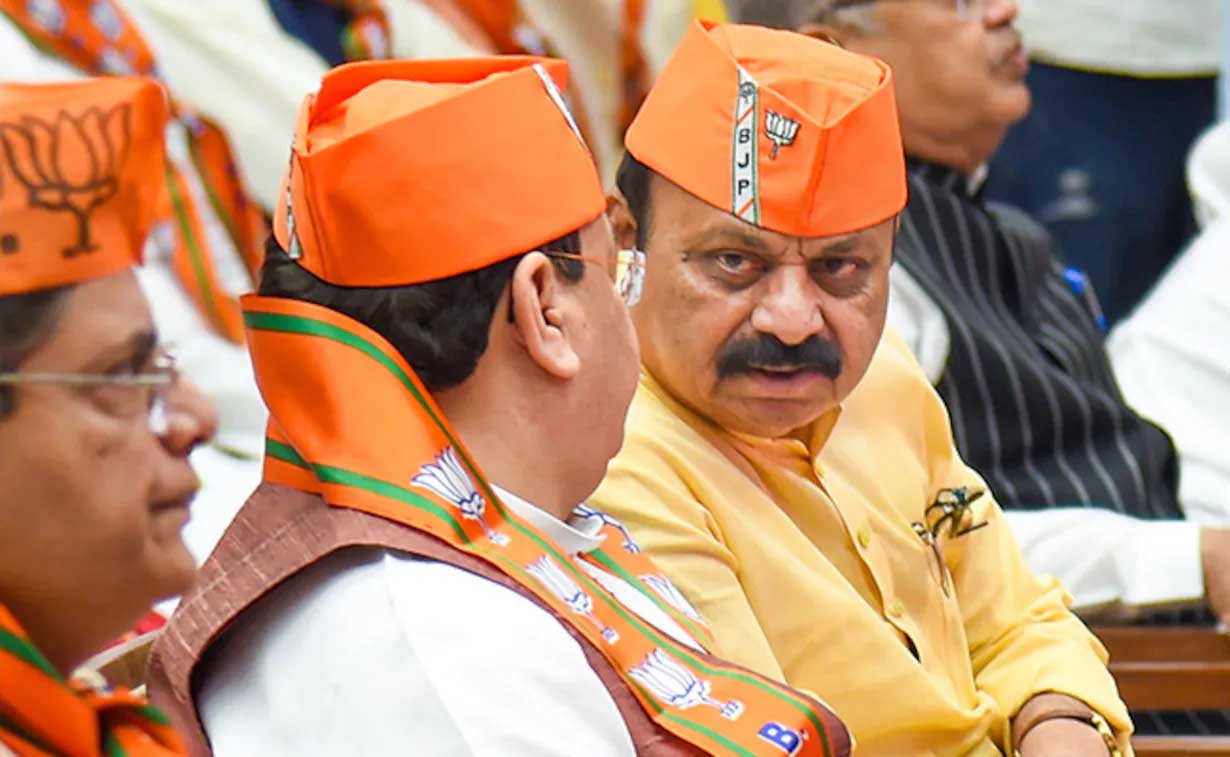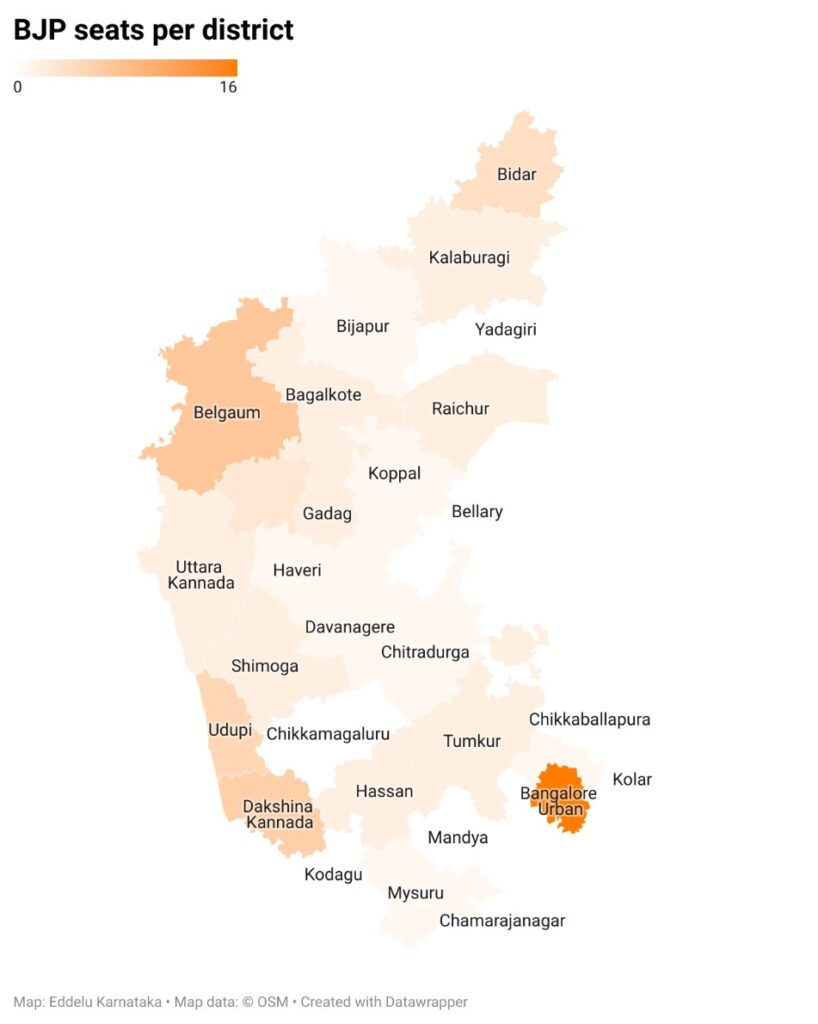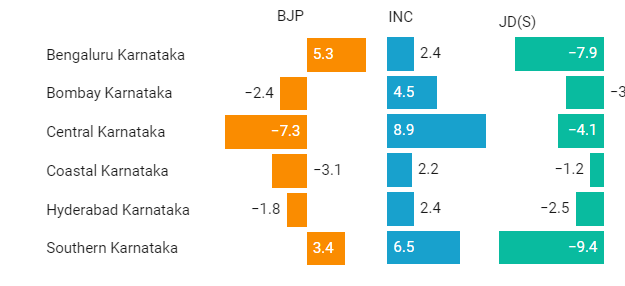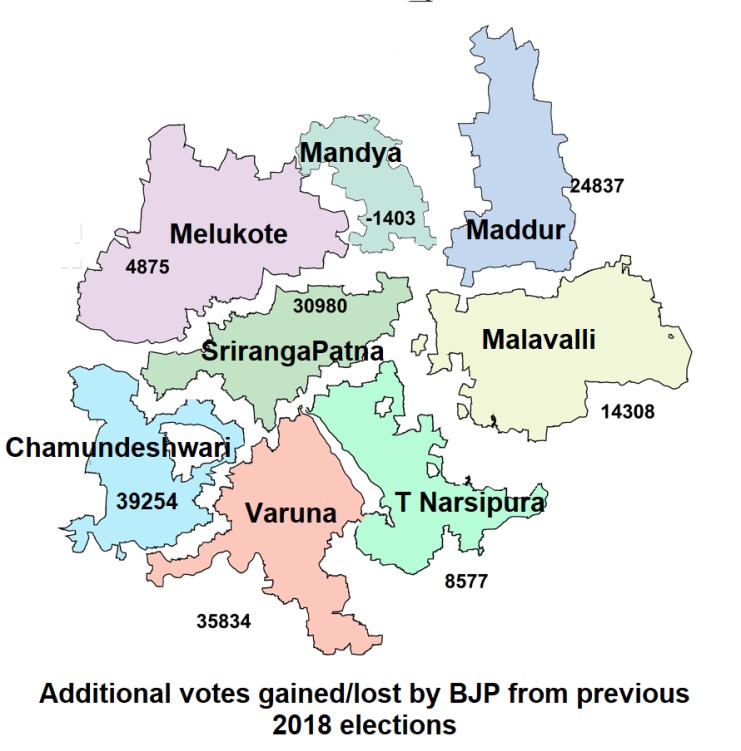In the recently concluded Karnataka Vidhan Sabha elections, the Congress performed well in terms of both the seats (136) and vote share (42.0) across all the regions of Karnataka, whereas the JD(S) experienced losses on both the fronts (19 seats and 13.3%). Although the BJP has seen a decrease in the number of seats from 104 to 66, it has managed to maintain its vote tally at 36 percent.
While the BJP’s vote share is low in many regions, it remains high in some regions. Various analyses of the BJP’s defeat are being discussed with in the progressive circles. These range from the extreme argument that the “BJP has lost all grounds” to the argument that “BJP’s communal politics not at all affected, even increased its strength in some places”.
This phenomenon calls for further exploration.
What has the BJP lost?
- Many top leaders of the BJP have lost miserably in the elections. CT Ravi, Somanna, R. Ashok, Vishweshwar Kageri, Murugesh Nirani, Halappa, Shankar Patil, B.C. Patil, BC. Nagesh, MTB Nagaraj, J.C. Madhavaswamy, K. Sudhakar, B. Sriramulu ….the list is long.
- BJP has failed to secure a single constituency in nine districts. Just one constituency in other 8 districts. Just two in another seven districts. This indicates a real poor performance of BJP in 24 out of the 31 districts of the state.
The BJP experienced significant losses even in its traditional stronghold regions of Chikkamagaluru, Kodagu, and Bellary.
- BJP could do fairly well (though the seat share shrunk from the lost tally) in five districts. In Belgaum, the BJP secured seven out of 18 seats, in Dakshina Kannada it won six out of eight seats, in Shimoga it won three out of seven seats, in Bidar it won three out of six seats, and in Dharwad it won three out of seven seats. In Udupi district, the status quo remained with the BJP winning five out of all five seats, while in Bangalore the number of seats for the party increased from 11 earlier to 17 this time.
- If we take six Administrative regions as reference, the number of seats for BJP has decreased in all the regions except Bangalore.
In Old Mysore, the seats have decreased from nine to six.
In the Coastal region, it has decreased from 18 to 13.
In central Karnataka, the seats have decreased from 24 to six.
In Mumbai Karnataka, the seats have decreased from 30 to 16. In Kalyana Karnataka, the seats have decreased from 12 to nine.
- BJP candidates have lost their deposits in 31 constituencies across the state, with a majority of them belonging to the old Mysore region.
- BJP suffered the highest vote loss in central Karnataka (-7.3), followed by the coastal region (-3.1), Mumbai Karnataka (-2.4), and Kalyana Karnataka (-1.8).
Vote Share
What the BJP has been able to gain?
- Bengaluru is the only region where the BJP has increased both its seats and vote share in the elections. In Bangalore, not only has the number of seats for the party has increased from 11 to 17, but the vote percentage has also risen from 35.8% to 41.2%. This translates to an additional 5,78,170 votes secured by the party.
- The number of seats for the BJP in the erstwhile Mysore region has decreased from nine to six. However, its vote share has increased from 18.2% to 21.4%. This indicates a 3.2% increase in votes. Notably, in Srirangapatna, the party witnessed a significant surge in votes, rising from 11,326 to 42,306.
The BJP’s vote share has also increased in the Maddur, Chamundeshwari, and Varuna constituencies.
What the BJP has been able to retain?
- In the coastal areas, particularly in Udupi district, the BJP has retained its dominance. It secured six out of eight seats in Dakshina Kannada district and retained all the five seats in Udupi.
However, the party’s overall vote share in the coast has decreased from 51% to 46.3%. This reduction is substantial. Nevertheless, the BJP has established a sizable vote bank in these two districts to the extent that even such decline in vote share is not enough to break their dominance in this stronghold of theirs.
- The BJP has managed to maintain its influence in Shimoga district. In addition to retaining the contested city of Shimoga, the party has also secured victories in Shikaripura and Thirthahalli.
- Similarly, the BJP has managed to maintain its presence to some extent in Belgaum district, Dharwad and the city of Vijayapura.
What do BJP’s loss, gain, and status quo indicate?
- While some interpreted the BJP’s defeat as a “shameful defeat of the politics of hatred,” some argued that though seats decreased “communalism has not got a beating anyway” pointing to the BJP’s sustained vote share and increased voter turnout in certain areas.
What would be a more factual assessment is to be seen from below.
- The Sangh Parivar attempted to provoke communal controversies as a strategic approach in the lead-up to the elections, approximately a year in advance, starting up racking Hijab issue. These attempts continued as the Halal, Jatka cut, prohibition on Muslim traders near temples, the murder of Harsha, the Darya Daulat controversy in Srirangapatna, propping Urigowda-Nanjegowda, and the Idris Pasha murder.
Furthermore, they employed their political power to implement communal policies, such as the Cattle Act, Conversion Act, textbook revisions, and the elimination of reservations for Muslims.
However, this strategy largely proved ineffective as they were unable to maintain power solely relying on this strategy of hate and divisive politics. Therefore, in an overall sense communal politics was beaten back significantly.
- The primary catalyst for minority communities voting in unison is their anger and unease towards hate politics. These communities not only got mobilized internally but also actively collaborated with ‘Eddelu Karnataka’ and other social movements to defeat the politics of hatred. Their collaborative collective community efforts had a significant influence on the final outcome.
- Considerable sections of Dalit, backward communities and a section of Lingayat communities also voted against the BJP. One of the primary reasons behind this shift is the increasing awareness and organised efforts among these communities in response to the BJP’s Manuvadi politics.
Furthermore, the BJP, which had previously managed to divide these communities by exploiting reservation policies, found itself ensnared in the same predicament this time.
Their attempt to offer relief without delivering tangible benefits ultimately led to a significant portion of the grassroots community turning away from them. Another significant development is the increasing awareness within the Lingayat community regarding Brahminization.
Along with this counter current, the feeling that ‘Lingayats have been neglected’ has resulted in a substantial number of Lingayat voters shifting their support from the BJP to Congress. These instances of heightened awareness within various castes have posed challenges for the BJP.
- The impact of price hikes has severely affected people this time. The BJP’s rampant corruption has significantly damaged its social reputation. The responsibility for bringing the issues of inflation and corruption to the forefront of public consciousness lies with a combined effort involving social campaigns, budding new trend media initiatives and the campaigning endeavours of the Congress party.
The combination of the heat of every day issues which touched the base and the political campaign which touched the minds set the voters mood, especially women voters.
- Simultaneously, the guarantees offered by the Congress are akin to providing water to those in a desert of distress. If debates on the usefulness and potential risks of these schemes persisted on the one hand, the common people found solace in the assurance that they would receive relief support during these challenging times. This instilled a sense of hope and optimism in the projections on Congress.
- Additionally, the BJP government’s introduction of the contentious anti-farmer laws and the resulting conflicts, anti-labour policies, increasing job insecurity, numerous struggles faced by various working sections, the struggle of the downtrodden sections for land, housing and NREGA schemes, the resistance from government employees against the New Pension Scheme, have all as a whole, played a significant role in distancing people from the BJP. Furthermore, the conscious efforts by these movements to mould people’s political opinions have also contributed to the overall dynamics.
- In sum, the collective awareness and unity among minority communities against the politics of hatred, the increasing dissatisfaction among oppressed communities, the impact of price rise and the burden of corruption, and the resistance generated within various communities due to the anti-people policies were all nurtured through the hard efforts of various social organizations and peoples media set the tone.
Together with this the efforts made by Congress by rising its voice against price rise and corruption, Bharath Jodo Yathra and the Guarantee promises instilled a feeling among voters that the BJP should be ousted. The Congress party has reaped significant benefits from this whole situation.
Does the BJP’s retained vote share reflect the success of communal politics?
- The analysis stating that the BJP has maintained its vote share (36%) despite significant defeats, implies that “Congress has won but communalism has not lost,” is partially correct but mostly inaccurate.
- The statement is partially correct because: while a majority of people voted against the BJP, it is important to note that not all of these votes can be attributed to a voting against hate politics.
Minorities and democratic sections of the people have consciously casted their votes against communal politics. This suggests that some sections of the voters did cast their ballots as a response to the BJP’s hate politics. It is also worth noting that for another big section of voters, other life issues hold greater significance than communal politics. But the biases infused by the politics of hatred or communalism still do persist in the minds of these sections also.
- In this election, several right-wing individuals have also switched their allegiance from the BJP to the Congress. They have also garnered some right-wing votes. Additionally, communal polarisation played a significant role in shaping the outcomes in Udupi, Dakshina Kannada districts, as well as the Shimoga-Belgaum, Dakshina-Hubli, and Vijapur city constituencies.
All this points to the importance of the immense work that needs to be done against the politics of hate and the danger of the kind of vicious atmosphere that communal politics can opportunistically create.
- At the same time it is also to be noted that in most parts of the state, not only has the hate politics card not worked but the increased voter share in majority areas can be attributed to reasons other than communal politics.
BJP has received the highest number of votes in Bangalore city, with a vote share of 5.4 percent, totaling 4,71,079 votes and resulting in an increase of 6 seats. However, it is important to note that these votes were not garnered solely due to communal politics. Instead, there are four primary reasons behind these electoral gains.
- Operation Kamala: The people who sold themselves and shifted from congress to BJP during Operation Kamala in 2019 (S. T. Somashekar from Yeshwanthpur, K Gopaliah from Mahalakshmi Layout, B. A. Basavaraj from K. R Puram, and Munirathna from RajarajeshwariNagara) have brought almost half the votes that BJP got in this election.
One aspect of Operation Kamala is, although many candidates have lost in this election they have contributed to the vote share of BJP. Their cumulative votes share in the entire BJP vote share is 2.86%. In the exceptional case of the Yeshwanthpur constituency, the BJP was able to secure 59,308 in 2018 elections, the Congress candidate S.T. Somashekar who had jumped to BJP in 2019 was able to secure 1,69,149 votes in 2023 elections.
| Operation Kamala Turncoats | Result | Votes Secured |
| MAHESH. IRANGOUDA. KUMATHALLI. | Lost | 55282 |
| SHRIMANT BALASAHEB PATIL | Lost | 74560 |
| JARKIHOLI RAMESH LAXMANRAO | Won | 105313 |
| PRATAPGOUDA PATIL | Lost | 66513 |
| BasavanagoudaPatil | Lost | 70358 |
| DR. K. SUDHAKAR | Lost | 75582 |
| B. A. BASAVARAJA | Won | 139925 |
| S.T. SOMASHEKAR | Won | 169149 |
| MUNIRATHNA | Won | 127980 |
| K. GOPALAIAH | Won | 96424 |
| N NAGARAJU | Lost | 102145 |
| NARAYANGOWDA | Lost | 38151 |
- Collapse of JDS: In Bengaluru this time, there was a significant decline in support for the JDS. Both the Congress and BJP have gained from this shift, but the BJP has emerged as the biggest beneficiary. Traditionally anti-Congress votes that were previously cast for the JDS have now shifted towards the BJP.
- The influence of Power and Money: Bangalore generally tends to favour individuals with financial resources and influential positions. This can be attributed to the city’s close proximity to the centres of authority and the well-established ruling power networks within the slum areas.
- Modi road show: The Modi road show campaign during the final phase of the election is also had a slight impact on boosting the BJP party to an extent.
In conclusion, it is primarily the aforementioned four factors, rather than communal polarization, that have played a significant role in shaping the political landscape of Bengaluru and resulting in the BJP’s significant gains.
BJP’s second highest gain is in the Mysore region.
- BJP has directed its utmost attention towards capturing this Vokkaliga majority area, which holds singular priority for them.
In their pursuit, the BJP has emphasised the involvement of influential leaders, Modi and Shah rallies, creating controversies surrounding Tipu, the fabrication of Urigowda-Nanjegowda fictional characters, and the distribution of substantial funds. They have utilized various tactics to achieve their objectives.
Despite these efforts, the BJP did not witness an increase in its number of seats; in fact, it experienced a decrease. It only managed to gain a 3.2 percent increase in the vote share.
However, it is important to note that the main reason for this outcome is not the communal politics it aims to promote. The primary factor influencing the election results in this area is the decline of the JDS.
Upon closer examination, it becomes evident that the Congress has benefited more from this situation than the BJP.
The Congress not only saw an increase in its seat count from 16 to 30 percent but also gained a 5.8 percent vote share.
On the other hand, the JDS, with its stronghold crumbling, experienced a decrease in seats from 24 to 13, resulting in a decline of 9 percent in its vote share.
While the Congress has benefited the most the BJP has also experienced some gains from this situation.
Additionally, factors such as the presence of popular figures like Sumalatha and Darshan, who are closely associated with the BJP, and the party’s strategy of enticing small leaders through substantial financial investments have contributed to their increased vote share.
The influence of these factors can also be observed in the voting patterns of Srirangapattana town. There is indeed a role of communal politics that the BJP has emphasized and attempted to cultivate here. However, it is not the sole determining factor. And It would be too simplistic to consider the 4,000-vote increase in Melukote as a significant reference point.
- The concentration of the entire BJP government machinery on the Varuna constituency to defeat Siddaramiah has also played a part in the neighbouring constituencies to win more votes. In spite of this, BJP could win only one seat in Mysore and Mandya out of 18 seats, in five seats it has secured the second position, and in 12 seats it could only manage to secure 3rd place.
- Communal politics is not the primary reason for the BJP’s increased vote share even in some other constituencies. While caste politics played a role in Bhadravati, personal image politics influenced the outcomes in Belagavi and Bagalkot. Additionally, the voter turnout for Yatnal in Vijayapur was also marred by fraud, as over 17,000 voters from other constituencies were discovered to have cast their votes using forged ballot papers.
- In sum, communal polarisation played a significant role in the BJP’s victory in two districts and four constituencies. And the influence of communal prejudice is deeply entrenched in general.
However, while the BJP has seen an increase in certain areas and maintained an overall vote share of 36 percent, it is important to note that this cannot be exclusively attributed to communal politics.
- BJP played the cards of Communalism, Caste politics, Operation Kamala and Huge Money to woo voters. In this the Communal card could not save them much, though communal prejudices continue to prevail, Caste politics boomeranged to an extent. Operation Kamala and Money power helped them to retain their vote share though it could not be materialised in seat share.
Is there any reason to celebrate or not?
There are several reasons to find some level of solace in this election result. Karnataka has effectively curbed the politics of hatred through strategic and concerted efforts, resulting in the removal of communal forces from state power.
Significant credit goes to the social forces that have actively shaped a narrative that diminished the influence of communal politics, while simultaneously highlighting the genuine concerns of the people.
People’s movements have played a vital role in exposing the BJP’s anti-people legislations, thereby unifying the secular votes and preventing divisions within the electorate. Even though the Congress made several mistakes this time, they have also shown prudence in their actions after a long period.
As a result of these collective efforts, authoritarian forces have been defeated. The masses, forces working on the ground, and the democratic intelligentsia are experiencing a profound sense of relief.
As a friend aptly put it, “Now, it feels like the air is oxygen-rich.” This outcome is the culmination of years of conscious action by multiple forces working towards a common goal. This should bring certain happiness and satisfaction.
However, it is important not to forget that although communal forces have suffered a setback in this election, the influence of communalism still persists, and its potential danger cannot be underestimated. There is every possibility that it may resurface in a more aggressive and violent form. Various forces are actively working towards this agenda.
Moreover, there are real concerns about the Congress party potentially enabling or allowing the resurgence of communalism through its mistaken moves.
We need to be glad about what could be achieved, draw the positive lessons from the same and constantly remain cautious not to fall a prey to any illusions and temptations. At the same time we should determinedly raise our voice against the probable mistakes by the Congress party and thwart the conspiracies of the BJP and its allies. On these lines, social forces must embark on a new phase of work to prepare the people for necessary actions.
(The author, Noor Sridhar is one of the coordinators of Eddelu Karnataka and Bharath is the analytical head of Eedina survey team)
Related:
Part One, Eddelu Karnataka, understanding a unique civil society experiment: K’taka assembly polls
Part Two, Actions taken in the campaign, Eddelu Karnataka: K’taka assembly polls 2023
Part Three, ‘Wake-Up Karnataka’, Impact Created, Lessons Learned





